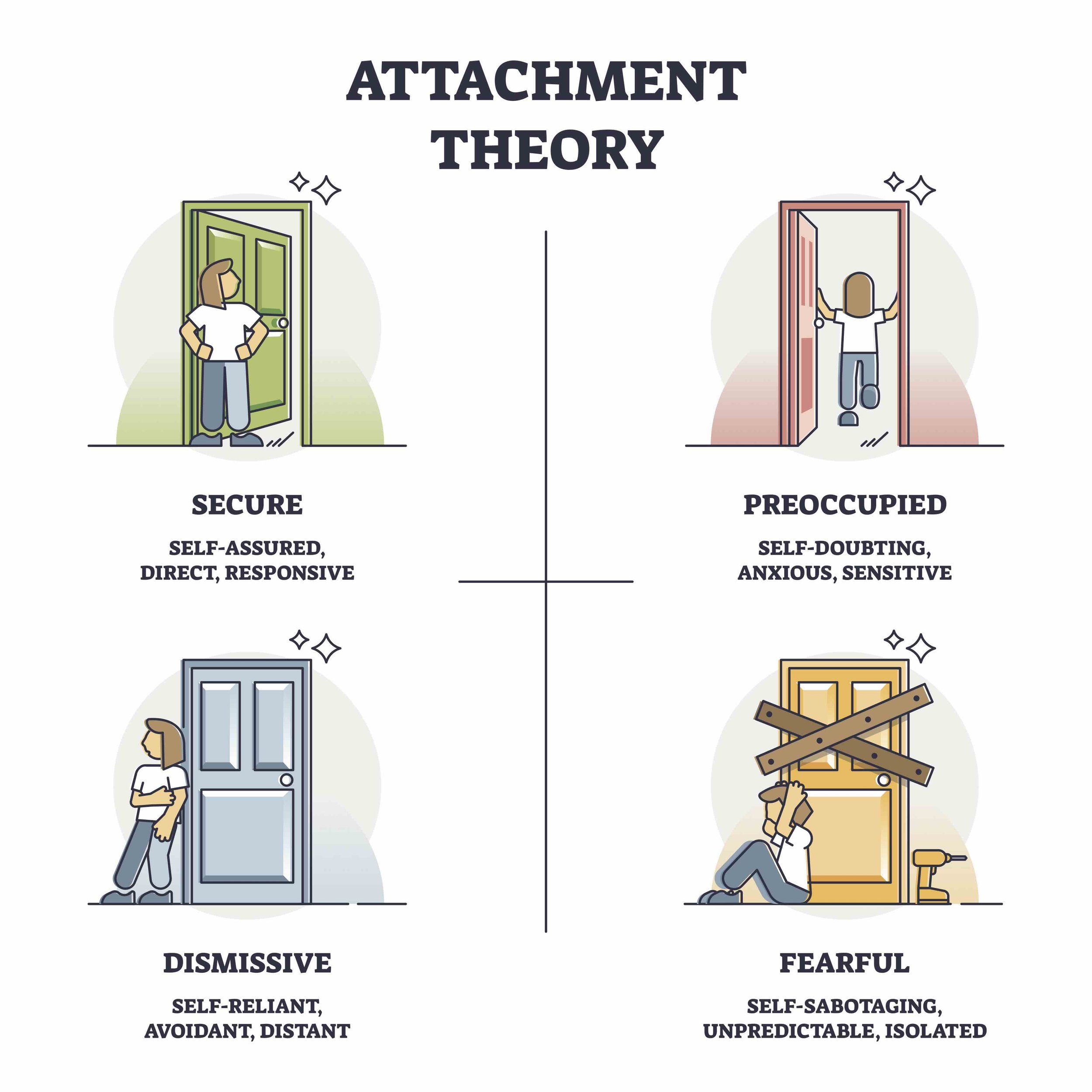How Avoidant Attachment Impacts Dating and Relationships
If you’ve found yourself regularly losing interest in your partners, running away from love or you can’t ever seem to find a partner who measures up to that ideal person in your head, exploring attachment style can be a useful way to understand how to create relationships where you have a really great connection and feel understood. Or perhaps you’re reading this because you’re dating someone with an avoidant attachment style, and you would like to understand them better.
Avoidant attachment is one of four Attachment Styles which describe how we connect and relate with other people. These attachment styles form when we’re very young, as infants or in the womb. People typically have a blend of the 4 different attachment styles but one primary style. The other 3 attachment styles also have judgy sounding names: they are the Anxious or anxious ambivalent style, disorganized or fearful style, and lastly, the secure style. Quick note: You might have heard the term Fearful Avoidant, and I cover that more in the post on Disorganized attachment. This post is more about Dismissive Avoidant attachment. Attachment researchers have found that the secure style tends to be correlated with relationship happiness and longevity.
So the 4 attachment styles I’ll be naming here are Anxious, Avoidant, Disorganized, and Secure. These are adaptations, because we are all wired for secure attachment and connecting with other people, and sometimes negative life or relational experiences get in the way of that and people develop these adaptations to cope with these less than optimal circumstances.
Avoidant Attachment Characteristics
So, how do you recognize avoidant attachment? People with the avoidant adaptation can often feel crowded or trapped when they’re in intimate relationships. This can result in them being labeled emotionally unavailable. This is partly due to the fact that they’re often not that comfortable with their own feelings and needs because they learned early on that it wasn’t okay to seem needy and they view people expressing needs, including their own needs, as being a burden. It can also be challenging to figure out what they need and want sometimes, and so in an intimate relationship when people often share feelings and needs with each other, this can be uncomfortable, both because they have to identify their own feelings and needs and because they are put in the role of helping other people and they can feel judgmental about others’ neediness. It’s kind of like if you were raised without ever getting to eat something you liked such as chocolate, and if you asked for chocolate you were scolded. And now you’re with someone who’s complaining that they didn’t get any chocolate in their lunch today, you might feel resentful and annoyed because you had learned to do without, so why couldn’t they? That’s kind of how avoidants can feel about other people expressing needs. They also feel pressure to perform and worried that they won’t live up to the person’s standards and will be criticized or put in an uncomfortable position.
People with avoidant attachment are more comfortable or more used to being independent, analytical, and task focused. They do tend to respect other people’s privacy and space and desire that respect from others, and this can be difficult in some relationships, particularly if they wind up with a partner who has anxious attachment style. You can find out more about this pairing in my post, Why do the Anxious and Avoidant Styles Attract Each Other? It can also feel hard to shift from being alone to being with other people.
In the avoidant style, people can go to great lengths to avoid rejection and criticism, for example, coming home as late as possible from work to avoid a critical partner, or ghosting someone to avoid a difficult conversation. This is because the avoidant attachment style often came out of a childhood that had a lot of criticism and blame, or subtle shaming when people shared feelings or needs. As a result, the easiest way often feels like avoiding interactions where a partner might be upset, or trying to convince a partner that what they’re concerned about isn’t actually a big deal. For the avoidant style, they have either suppressed their feelings to the point where things don’t feel like a big deal, or have become good at distracting themselves from their feelings.
Typically, they come from a childhood where other people did not provide soothing or help them identify and accept their feelings and needs, so they become highly independent, and they are typically used to self-soothing, though this may come in the form of distractions, where they throw themselves into work, hobbies, fitness, video games, web browsing, etc.
The Avoidant and Dating
So when it comes to dating, many avoidants are drawn to shorter more casual relationships, because deeper intimacy can require more expression of feelings that can be uncomfortable for them. In the beginning stages of dating, when there isn’t as much deep emotional depth required, they can get certain needs met such as fun, adventure, companionship, physical intimacy, and enjoyment.
One of the challenges in dating for someone who has avoidant attachment can be finding compatible partners who don’t seem to take up too much time from competing pressures such as work and fitness. If an avoidantly attached person and an anxiously attached person try to get into a relationship, and by the way it’s common for them to attract each other, there is often some discussion around how much time they are spending together, and when, since someone with anxious attachment will likely want more time together and be dissatisfied with an avoidant’s schedule and priorities, and this dissatisfaction will feel like a criticism to the more avoidant partner, who then feels put upon and trapped, and thinks the anxious partner is wanting more from them than they are able to give. In this case they often leave before the relationship becomes particularly serious.
Avoidant Attachment and Relationships
So what is it like for someone with avoidant attachment when they’re in a relationship?
People tend to enter relationships quickly but after a few months realize that it’s not quite right or the emotional closeness is getting too demanding, and then move on or think about other relationships that might be better. It can be tempting to focus on a relationship from the past, the proverbial one that got away, or an ideal, perfect dream relationship. Particularly if a partner is too giving, an avoidant can find them boring, whereas a partner who plays hard to get can be seen as a challenge and more interesting, sometimes due to an underlying belief that you have to work to get love. And although avoidants can be seen as commitment phobic, they do take commitment seriously.
In general, this attachment style tends to be less emotionally connected to their partners than other styles, and find it difficult to be relied on or provide consistent connection and loving gestures, which many people, especially the anxious attachment style like to receive from their partner. Sometimes their partners make requests which seem small to the partner, but feel huge to the avoidant attacher, and this can make them feel overwhelmed and tend toward distraction, withdrawal, or if those aren’t possible, shut down.
The avoidant adaptation can get a reputation for being afraid of commitment, and a lot of relationships don’t last long. That being said, the avoidant adaptation can find long-term relationships when they find a balance between connection and alone time, and do the deeper work of becoming more comfortable with their feelings and those of their partner. They also feel more comfortable in relationships where they are seen and understood, as those were often needs left unfulfilled in childhood, as long as that understanding does not come with demands, but instead comes with recognition and acceptance that they need space at times.
You can guess that you might be dating someone who is an avoidant attacher if they do many of the following:
Though they may have been talkative and interested in getting to know you, even warm and charismatic, over time they become more withdrawn; they say that they had a good childhood but don’t have a lot of emotions attached to events or remember much detail; they judge you or others for not being as independent or self-sufficient as they are; they prioritize work over personal relationships, and may have difficulty committing to plans, arrive late because of a work engagement, or be distracted by technology while you are together. They may imply they have feelings for you but seem reluctant to say “I love you”.
Triggers - for the avoidant attachment style
Triggers for an avoidant attacher include being criticized by people close to them, being in a situation where they are expected to share their emotions, thinking that a relationship is taking too much of their time, being asked for attention or other needs from a partner, or a partner getting emotionally close.
Deep down people with avoidant attachment would like emotional and physical intimacy like anyone else, but feelings can make them uncomfortable, so this conflict can cause them to detach from their innate human needs for connection and intimacy.
Shifting to Secure
There is more and more recognition that it is possible to shift our attachment style to become more secure, and this is done through learning about our attachment tendencies and working to change them for more secure behavior, as well as getting more in touch with our innate human feelings and needs. I teach people how to create corrective experiences that help the attachment system to experience ease and enjoyment in connection. In the case of avoidant attachment style, this involves having the experience of being seen and understood, building comfort around identifying and asking for needs to be met, communicating with greater depth of emotion and greater understanding of a partner’s emotional states, and learning alternatives to the withdrawal, dissociation and shut down strategies that people can be using to cope.
I mentioned earlier than the anxious and avoidant styles often attract, and if you want to know why and how to avoid this particular dynamic, you can check out my post on why the anxious and avoidant styles attract each other.
Please feel free to share your thoughts in the comments below.





